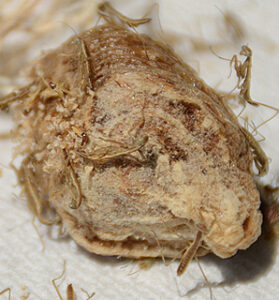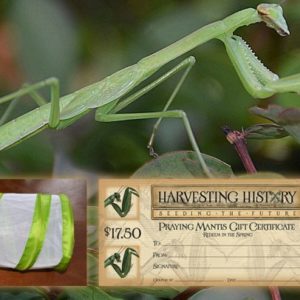Description
 Praying Mantises:
Praying Mantises:
A Bug Every Garden Should Have
There are approximately 2400 different species of mantids living in all the temperate and tropical regions of the planet. In the US, there are 20 native species, and in Canada, there is one native species. Species from China and Europe have been intentionally introduced into the US for pest control purposes, and these species have flourished as well. In fact, you are as likely to find a Chinese or European praying mantis in your garden as you are to find a native one.
The closest relatives to the praying mantis are termites and cockroaches. At one time it was believed that praying mantises were related to stick bugs, but that has proven to be untrue. The name, Praying Mantis, is taken from the shape and position of the insect’s front legs which appear to be folded in prayer. The scientific name, mantodea, is formed from two Ancient Greek words, mantis meaning “prophet” and eidos meaning “form” or “type”. The term “praying mantis” was first coined in 1838 by the German entomologist, Hermann Burrmeister.
Mantises come in long-winged, short-winged, vestigial winged and wingless forms. They protect themselves through camouflage and concealment. Their entire bodies can turn from dark brown to bright chartreuse green.
Praying Mantises are incredibly skilled, aggressive hunters. They eat many different kinds and sizes of insects depending on the mantis’ size and stage of development. Their mode of hunting is usually to ambush their prey, but they have been known to chase especially desirable prey for short distances. Their eyes have a visual range of 50 feet, and they are primarily diurnal, but they have been known to fly at night. This is especially true of males who will fly at night during mating season.
Praying mantises have three primary life cycle stages: egg, nymph and adult. The egg stage begins in late autumn after a female has mated. The female then excretes a cream-colored substance that resembles rubber cement in consistency onto a stem or the bottom of a leaf. As the substance dries it turns brown and forms a small (usually 1 inch long and wide) somewhat round mass that looks very much like a tiny hornet’s nest. Inside this egg case which is called an ootheca, the female praying mantis has deposited between 200 and 400 eggs. The egg cases can survive very harsh winters and very wet springs, but they cannot survive attacks from birds and other animals that are prone to eat them.
In spring the second stage of the life cycle unfolds. The eggs hatch and the tiny nymphs eat their way out of the egg case. The nymphs as they first emerge are nearly perfectly formed little praying mantises. They are voracious eaters and will readily evidence cannibalistic behaviours if there is no other food source available. Fruit flies, aphids and white flies are excellent food sources for the praying mantis nymphs.
By early summer, the praying mantises are into the third and final stage of their life cycle – the adult stage. During this stage the mantises are growing very rapidly. They will shed their exoskeletons in a molt up to 10 times during the summer. As they grow, the prey that they will hunt and consume will also increase in size. The most common food sources include moths, crickets, flies and grasshoppers, but praying mantises have been observed devouring small lizards, birds, rodents, frogs, snakes and fish. Unfortunately, praying mantises will eat other beneficial garden insects like butterflies. As adults, praying mantises will not wander far from where they are released unless the food sources are insufficient.
IT IS IMPORTANT TO REPORT HERE THAT PRAYING MANTISES EAT STINKBUGS. IN FACT, THEY ARE AGGRESSIVE PREDATORS OF THIS PEST!
Praying mantises live from 6-14 months depending on the species. One of their final acts is to mate. Even for a praying mantis, the act of mating involves a bizarre ritual. During this ritual, the female is known to often practice sexual cannibalism. The female bites off the male’s head, and if this happens after penetration has occurred, the act of decapitation causes the male to respond with a jerky movement thus delivering the sperm more efficiently. There is insufficient scientific data to suggest that the decapitation is biologically motivated, but the anecdotal evidence certainly seems clear.



